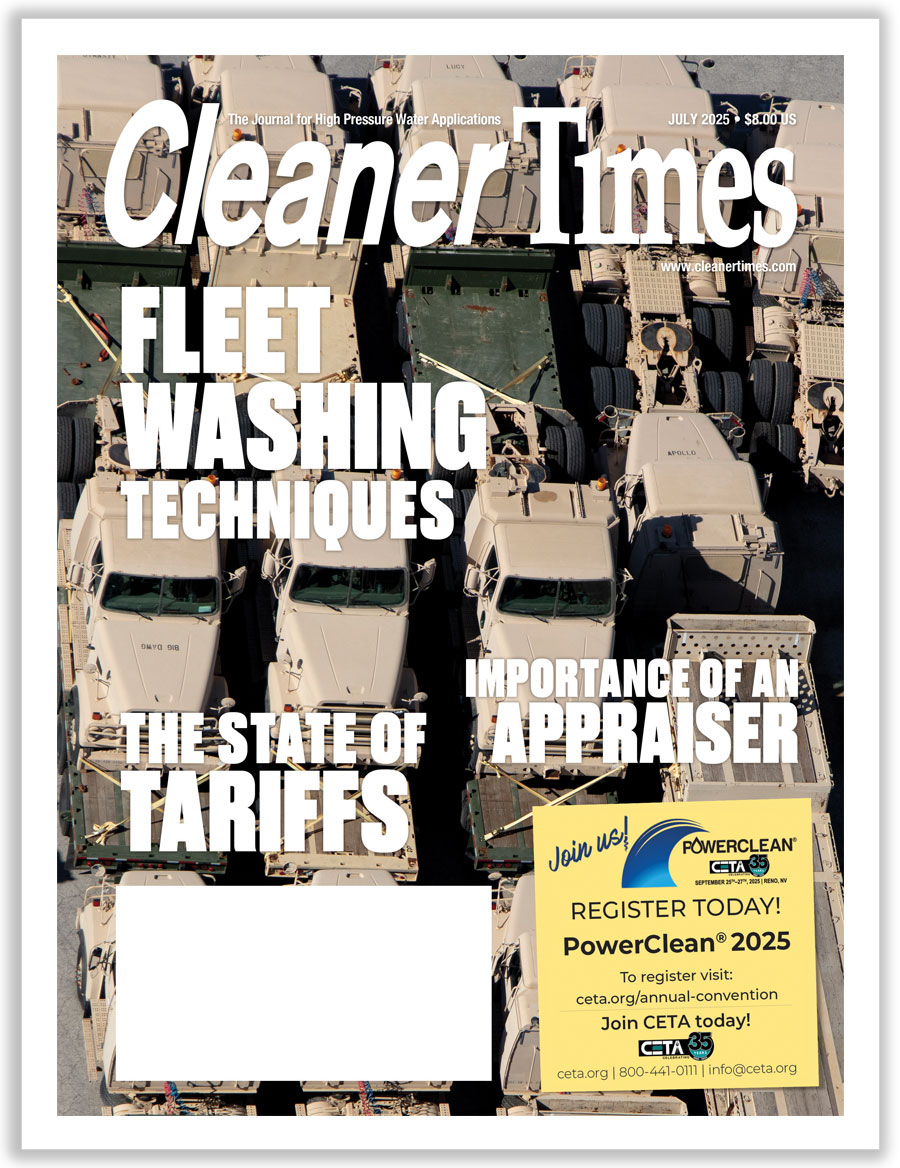
“Stepping Away from the Wand,” Part One
Why You Should Not Do All the Work
by Mike Dingler / Published December 2021

For those of us who have been to an industry convention, read a business book, or have heard any “gurus” present the idea that you, the business owner, should not do all the work, why? Why can’t exterior cleaning business owners do the physical work that makes us money? A lot of us really like doing all the work, and a lot of us (surprise, surprise) have a mental outlook that says, “No one can clean properties as good as I can,” and, “If you want something done right, you gotta do it yourself.” There is nothing wrong with this outlook; it is our “Type A” personality that got us where we are today, but if you want to scale your business and have multiple rigs on the road, “What got you here won’t get you there” is the mental outlook you as the business owner will need to adopt. If you are a successful business owner, what got us here is a lot of hard work, blood, sweat, and tears. We sacrificed parties for pressure washing patios, we sacrificed a social life for social media marketing, we washed in the middle of the night instead of sleeping, and so on. We paid a high price to get where we are, and we have correlated our success to our sacrifices and to our time doing the work. That must change if we want to grow, both in business and in life.
The main issue about doing the work yourself or doing the work with a helper or two under your direct control is that it is really just you out there doing the work. You tell your helpers to help, and that’s what they do: help, not lead. They water down plants when you are on the roof. They pull hose line while you soft/pressure wash. They clean the lower windows while you clean the high ones. They pack up while you talk to the customer. They don’t know as much as you do about the industry, the tools, and the tactics, basically the “wash life” that we have all grown accustomed to, and that’s why they are helping you instead of running their own exterior cleaning business, right? Wrong. They are helping you because they are employees. A lot of us business owners need to realize that not everyone wants the life we want. Not everyone has a “Type A” personality. Not everyone knows how to run a pressure washer, much less a company that does it for other people. Simply put—some people would rather work 40 hours a week for someone else and not 60–80 hours for themselves, and there is absolutely nothing wrong with that. If everyone were like us, we might be working for them! With that clarification, we need to move on to training our helpers to be our lead technicians, and so begins the process of stepping away from the wand.
Stepping away from the wand, getting off the truck, getting out of the field—call it what you want, the end result is the same. It’s the process where you trust someone else with everything you have worked to build, and it is not an easy process. The process of stepping away from doing the work is a different process for each exterior cleaning business owner because each of us is different and in a different location. Just like people asking for help with pricing on the online exterior cleaning forums, it is whatever your local market will tolerate. We all run our businesses differently and have different financial parameters to abide by, so we have to pay our technicians differently. If you are looking to step away from the wand, here are a few things to get you started:
- Be completely insured.
- Have a brand including logos and uniforms.
- Have a dedicated business phone line.
- Have at least one person in mind who can do the work in your absence (not your spouse).
- Have an operation’s manual in progress.
- Have a safety manual in progress.
- Have all SDSs for chemicals you use on file in the trucks.
- Be legit. No “under-the-table” operations (paying helpers cash, bartering, etc.).
- Prepare all pertinent employee paperwork BEFORE you hire your first employee.
- Whatever you think you will be able to pay, make it more.
- Get a CRM (customer relationship management) system. No excuses.
All of these are a very basic list of items you must have in place in order to successfully scale your business. Insurance is a must because you are a legitimate business that provides services at other people’s homes. You may be careful and know not to spray an electrical outlet with water, but your future employees may not be. Also, your employees will be driving your trucks, so make sure you have a commercial auto policy in place.
It’s insurance that fixes your mistakes, but it’s the operations and safety manuals that train employees to not make them in the first place, so you MUST start on your SOPs (standard operating procedures), mission statement, and safety regulations now.
When you have your first employee, he will want to see your vision of where the company is going as well as WIFM (what’s in it for me). WIFM is an attitude we have all had at one point in our life when we worked for someone else. Employees don’t care how much you know until they know how much you care. They need to see that you care enough about your business and the future of the business by writing it down and formulating a plan. If your plan is to have 30 technicians, an operations manager, a sales manager, and an office manager, write it down and make an organizational chart. An organizational chart is paramount, and it is very easy to do! Form an introductory letter that tells your new hire what he signed up for and what he should expect from you and your company. End that letter with your mission statement and explain it. This creates a clear picture of what you expect from the employee going forward. All of these things plus many more will be addressed in next month’s article, “How to Train Others to Do the Work that You Do So Well.”
Why you should not do all the work is a simple concept to grasp. If anything happens to you, it also happens to your business. If you get sick, your business suffers with you. If you get hurt, your business is hurt with you. Nothing on your work truck should be the only one you have on the work truck (one is none and two is one). This means you must have two or more of every-thing if you need one of them to be there and work properly when you need it. The same is true about per-sonnel. The problem with having you, the owner, in the field with helpers is that there is just one of you. If you go down, the whole business goes down.
Scenario: You are the owner-operator, and you hurt your back. You schedule a doctor’s appointment (one missed job), then the doctor sends you for an MRI (two missed jobs), then the doctor asks you to come in and review the results (one missed job). That simple scenario has cost you four missed jobs. Fill in your job average (total year’s income divided by the year’s job total) on the line, and you will calculate what the doctor’s visit cost you, besides your co-pay and fuel to get there.
________________ x 4 = $ missed out on due to doctor’s visit
The number you just calculated is very minimal compared to what happens next. The doctor says you have herniated the L5 vertebrae in your lower back from when you tried to look cool in front of your helpers and move a 40-ft. ladder by yourself. It requires a very minimally invasive surgery to go in and cut the herniated tissue away from the nerves that it is currently compressing, the nerves that make you feel like your leg is on fire all the time. It is extremely painful, and surgery is the best option compared to constant pain and a year or more to recover from it if you go without the operation. The surgery requires a one-year full recovery time, and for the first three months you cannot pick up anything over 10 pounds; you cannot bend, lift, or twist; and you cannot bend down and pull anything across the ground. So, you schedule your surgery date (three to five jobs lost) and your recovery time (832 jobs lost). This is obviously a deal breaker, and if you don’t have anyone to take over, you may be going under. One is none and two is one.
________________ x 835 = $ missed from discectomy surgery and recovery time
This scenario has happened to blue collar workers across America. It is not a hypothetical scenario; it has happened to at least one exterior cleaning business owner for certain. Luckily, that owner had systems in place for the team of technicians he had trained to take over, and that business is alive and thriving today. If that same company had not had an owner who had stepped away from the wand and stopped doing all the work years before his injury, the outcome would have most likely been a failed business. It was important for that owner to have done everything to get off the truck long before his injury occurred so that the mission statement, operations manual, safety manual, and weekly technician training meetings built a business where no one task was carried out by a single individual in the organization. One is none and two is one.
So now that we have explored why you should get off the truck, use this month to start preparing your checklist above. You will need to have everything in order for when you begin training technicians to work in your absence, next month’s topic. Until then, start brainstorming and remember that one is none and two is one!
Mike Dingler is owner of Firehouse Pressure Washing, Soft Washing, and Roof Cleaning Inc. He has been in the exterior cleaning industry since 1996. In addition, his book, Small Service Based Business Basics: How to Run Your Business and Not Let Your Business Run You, is available on Amazon. For more information, call (770) 468-0014 or visit www.firehousepowerwash.com.





